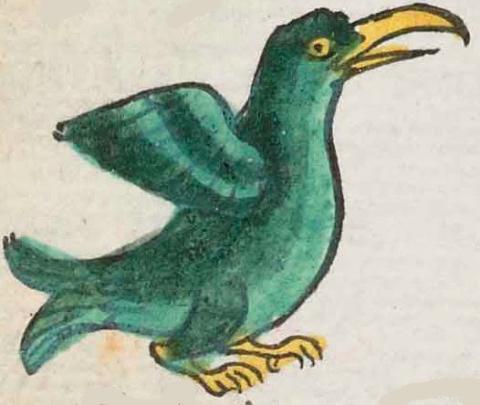Huitzillan (Mdz24v)
This simplex glyph showing a hummingbird [huitzil(in)] also stands for the place name Huitzillan. The bird is a two-tone green, in profile, facing to the viewer's right. Its short wings are lifted and its yellow beak is open. The visible eye is open. The feet are yellow.
Stephanie Wood
Unlike the other glyph in the Codex Mendoza that also represents Huitzilan, this one does not make the locative suffix (-tlan, place) visible. So, this one is a simplex and the other is a compound. It is interesting that the locative does not have to appear visually.
Stephanie Wood
huiçilan.puo
Huiitzillan, pueblo
Stephanie Wood
c. 1541, but by 1553 at the latest
Stephanie Wood
hummingbirds, birds, colibríes, ave, aves, pájaro, pájaros, pluma, plumas, animals, animales

huitzil(in), hummingbird, https://nahuatl.wired-humanities.org/content/huitzilin
-tlan (locative suffix), https://nahuatl.wired-humanities.org/content/tlan
"Hummingbird Place" [Frances Karttunen, unpublished manuscript, used here with her permission.]
"By the Hummingbirds" (Whittaker, 2021, 101); "Where There Are Many Hummingbirds" (Berdan and Anawalt, 1992, vol. 1, p. 188)
HUITZIL-lan
"El Lugar del Colibrí"
Stephanie Wood
Codex Mendoza, folio 24 verso, https://digital.bodleian.ox.ac.uk/objects/2fea788e-2aa2-4f08-b6d9-648c00..., image 59 of 188.
Original manuscript is held by the Bodleian Libraries, University of Oxford, MS. Arch. Selden. A. 1; used here with the UK Creative Commons, “Attribution-NonCommercial-ShareAlike 3.0 License” (CC-BY-NC-SA 3.0)




